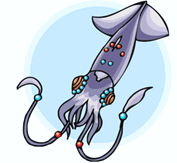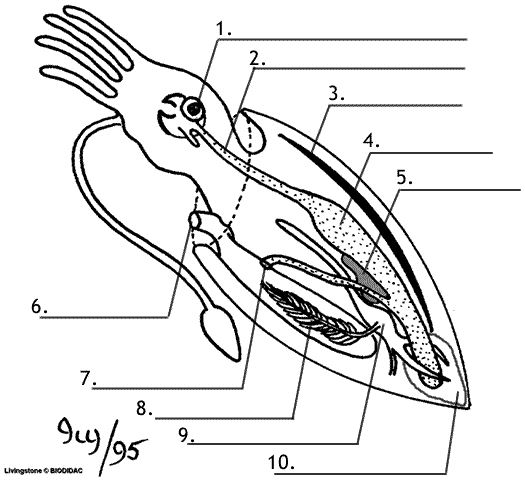*Exploring Cephalopod Anatomy - A Comprehensive Squid Dissection (new version)!
Squid Dissection - The Anatomy of a Cephalopod 
External Anatomy:
Find each of the parts, check the box to indicate that you found it.
1. Locate the water jet. The water jet is found on the ventral side of the squid. ![]()
2. The tentacles (long) and arms (short) are attached to the head of the
squid. ![]()
3. Find the two large eyes on the side of the head. ![]()
4. Locate the body, which is covered by the mantle, and locate the two fins. ![]()
5. Each arm has sucker disks, count the number of sucker discs on one
arm: ____ ![]()
Sketch the external view of the squid; label all the parts that are underlined above.

Finding the Jaw
Open up the arms and remove any that are in your way. Deep in the middle of the arms is the mouth and a beak-like jaw. These are located in a bulbous structure called the buccal bulb. Use forceps to remove the bulb and then the jaw (beak) Draw the beak in the box.

Analysis
1. How many arms does the squid have? _____ How many tentacles? ______
2. What is the function of the arms and tentacles? ______________________
3. What is the function of the water jet? ____________________________
4. Name two features that are adaptations for the squid's predatory life. _________________________
5. Name two traits that the squid shares with other mollusks. ____________________________
6. To what kingdom does a squid belong? __________________
What phylum? ________________
What class? _________________________________
7. Name one other organisms in the same CLASS ___________________
 Internal Anatomy
Internal Anatomy
Procedure: Turn the squid ventral side up. Pull the mantle up with the scissors where the water jet is, it should be loose and easy to pull up. Use scissors to cut from the water jet to the fins. Open the mantle to expose the structures inside and pin.
1. Find the ink sac, this is a small dark sac near the water jet. Remove the ink sac and use your dissecting needle to break the pouch. Write your initials on this paper in squid ink or just smudge the paper. ![]()
2. Find the esophagus, this is best found by looking into the mouth and seeing where it leads. The muscular mass that surrounded the beak can be pulled up (and out) to show the tube that is the esophagus. ![]()
3. To find the stomach, follow the esophagus toward the posterior. ![]()
4. The anus empties into the water jet, use scissors to cut the water jet down the center so you can see the small opening of the anus. ![]()
5. Locate the gills, these are feathery structures that may be hidden under other things, there are two of them. ![]()
6. Follow the gills toward the interior to find an enlarged structure at their base: this is the gill heart. ![]()
7. All the way toward the fin is a whitish or yellowish structure: this is the gonad. The male gonad is generally white, the female gonad is usually more yellow to clear. Is your squid male or female? ![]()
8. The hard shell-like structure that lies along the backside of the squid is the pen. See if you can remove the pen in one piece. The pen serves to stabilize the squid while it swims (like our backbone). ![]()
Observations and Analysis
1. How many gills does the squid have? _______________________________
2. Where does the ink sac empty into? ___________________________________
What is its function? ___________________________________________________
3. What is the function of the pen? ________________________________________
4. Where do wastes exit the squid? (be specific) ___________________________
Use the descriptions in the lab handout to help you label the squid
Word Bank
Stomach | Ink sac | Esophagus | Gill | Heart | Gonad | Anus | Pen
*Exploring Cephalopod Anatomy - A Comprehensive Squid Dissection (new)!

